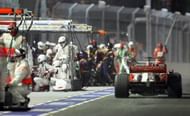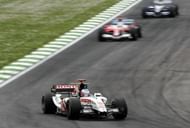Flashback
Formula One has been the pinnacle of motorsport for the past 50 years and has seen a number of world champions, from Giuseppe Farina to James Hunt, Niki Lauda, Alain Prost, Ayrton Senna, Michael Schumacher, Kimi Raikkonen and Jenson Button. From four time world champion Sebastian Vettel to defending world champion Lewis Hamilton, Formula One has seen them all.
With each turn of the decade there were more and more awe-inspiring advancements in technology. Since its debut in the 1950s cars were not as streamlined as they are now due to the absence of a front and a rear wing. In terms of power, speed has been increasing slowly but surely for many years, as each team looks for the extra edge in performance to emerge on top.
A multitude of manufacturers like Mercedes, McLaren, Ferrari, Lamborghini and several others began supplying engines. Manufacturers like Honda and Toyota joined the fray in later years. However as regulations evolved and costs increased, more and more manufacturers opted out of the competition or returned when the time was right. Honda rejoined this year to partner the struggling McLaren team, although they are still in the process of integrating themselves into the new system. There were also ‘Tire Wars’, where multiple tire manufacturers competed with their respective teams to see which was the better tire. These included Goodyear, Dunlop, Bridgestone, Michelin and Pirelli.
Rulebook Breakdown

2007 witnessed multiple changes, with the reintroduction of slick tires and Michelin pulling out of the sport, leaving Bridgestone the sole tire supplier. A few years later, Bridgestone pulled out as well and were replaced by Pirelli. With Pirelli’s contract expiring soon Michelin are poised for a return as the sole supplier. A new innovation to bring the competition closer was the introduction of the ERS and the DRS system (No relation to its cricket namesake).
The Energy Recovery System (ERS) is basically KERS version 2.0. Whenever a driver brakes the energy is stored and charges a battery, which the driver activates to get a boost for a few seconds. It can be likened to a nitro boost. The difference is that no matter how much ERS is used, with each lap the battery charges to its full capacity so the driver has unlimited use throughout the race but could be in trouble if he uses up all the energy too early, leaving the driver at the mercy of the chasing pack.
The DRS or Drag Reduction System is a different matter altogether, activated after the entire field completes 2 full laps. A driver can only use the DRS if he or she is less than a second away from another car so the leading car could be at a disadvantage unless he or she pulls a big enough gap to break the tow. Also, the DRS is only limited to certain sections of the track called DRS Zones, and deactivated immediately after leaving the designated zone. It is deactivated during a safety car period or when there are wet conditions.
Another major rule change was the ban on refueling, which was a part of a go green scheme. Drivers and teams had to monitor their fuel consumption and try and finish the race on one full tank of fuel. This has forced the drivers to save fuel to last the entire race distance instead of flat out attacking speeds.
What has gone wrong?
Despite the various innovations Formula One seems to have lost the plot somewhere. Many classic circuits like Magny Cours and Imola were dropped from the calendar and now there are rumors of Monza being dropped although Imola is currently in talks to host the Italian GP to save the sport in Italy. For the current Formula One season Germany was axed from the calendar due to high maintenance and running costs and poor attendance.
Another serious problem is the rising cost for both fans and the teams. The hiked prices for tickets have led to dwindling audiences, and rising costs to manufacturers to even stay in the sport and develop the cars have taken a toll on the teams, especially the smaller ones. Caterham’s factory was raided, following which they were forced to pull out 2 races before the 2014 season wrapped up due to financial losses.
Marussia nearly suffered the same fate, if not for a now seriously tragically injured Bianchi with a fine 9th place and 2 well earned points. Each point a team scores is worth a lot monetarily, so the 9th place finish sealed their berth on the 2015-starting grid. However, the prize money they received was not sufficient for their needs, meaning they are currently competing in the 2015 championship with a 2014 model, which was modified to suit the current technical regulations at the time.
This begs the question “Is the Sport Dying?” Formula One has been at the receiving end of a load of backlash by a disgruntled fan base. What is the missing ingredient to build up an audience base and satisfy the drivers’ hunger for competition? Several solutions are already being thought out while I write this article. For example, lifting the ban on refueling to improve the strategy decisions, closed cockpits for safety purposes especially considering Jules Bianchi’s near fatal accident in Suzuka 2014, which has left the popular Frenchman in a vegetative state. More rules like pitlane regulations, where the team has to make sure that the tires are fitted properly and a limit on the number of mediapersons in the pit lane were implemented, especially after a loose wheel from Mark Webber’s Red Bull accidentally hit an unsuspecting cameraman in 2013.
One of the main observations as to why Formula One has been a turn off for most fans is possibly the excessive dominance by one driver. For example, between 2010 and 2013 Sebastian Vettel swept up four straight championships, but in 2010 and 2011 he did not have it easy because he faced stiff resistance by Fernando Alonso, Lewis Hamilton, his own teammate at Red Bull, Mark Webber, and Jenson Button. In 2012 and 2013 however he was invincible. In 2014 and now 2015, Mercedes broke the stranglehold and instead formed a new world domination conquest. One could argue that Michael Schumacher’s domination was unhealthy for the sport but Schumacher faced a multitude of fierce rivals during his career. Duels of this quality, however, are the very life force of Formula One.
Some of the older and experienced drivers in the current grid believe it is necessary to go back to the days when they were debuting or at the peak of their careers to recapture the interest of Formula One fans worldwide. Earlier in the Schumacher era Formula One meant fast cars, gutsy drivers with death defying moves and more engine grunt, not whining lawnmowers ambling around like a multimillion euro procession, devoid of risky no holds barred action.
Recently, the Grand Prix Drivers Association (GPDA) headed by Jenson Button, Sebastian Vettel and Alexander Wurz launched a global survey asking Formula One fans what changes they would like to see in Formula One. This move was undertaken because the drivers wanted to hear the fans’ opinions as well so that together the Teams, the Drivers and the Fans could work to bring a radical change to Formula One, hopefully for the better.

